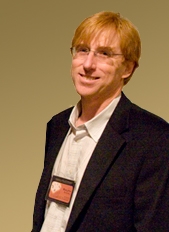Rutgers Mourns Neuroscientist Ralph M. Siegel, 52, Who Explored the Neural Processes of Vision
Dr. Ralph Mitchell Siegel, a researcher who studied the neurological underpinnings of vision, died Sept. 2 at his home following a long illness. He had been a professor of neuroscience at Rutgers University, Newark, in the Center for Molecular and Behavioral Neuroscience (CMBN).

Siegel, a resident of West Orange, N.J., is survived by his wife of 23 years, Jasmine; his children, twins Dashiel and Zoe; his sister, Cheryl; and his mother, Elaine. Funeral services were held Sept. 4 at Temple B’nai Shalom in West Orange.
As a trained neurophysiologist, Siegel’s work investigated basic mechanisms underlying visual motion and spatial perception, with the ultimate goal of developing applications to assist people who have visual processing disorders and neurological injuries. He performed pioneering work on the brain’s parietal lobe neurons and the influence of eye position and attention on perception. His laboratory was prominent for performing optical imaging of the parietal cortex.
According to Drs. Paula Tallal and Ian Creese, co-founders of the CMBN, “Ralph Siegel was one of the first faculty members to be recruited to the new Center for Molecular and Behavioral Neuroscience at Rutgers University in Newark in 1989. As his research spanned broadly from systems neurophysiology to psychophysics to computational models of complex visual processing, he was an ideal faculty member for the new research center.”
Siegel earned his B.S. in physics and his Ph.D. in physiology from McGill University in Montreal. After completing his graduate studies at McGill on theoretical neuroscience of spike propagation in branched dendrites, he moved to the Salk Institute in La Jolla, CA where he began to focus on in vivo, behavioral neurophysiology in the lab of then assistant professor Richard Andersen.
Dr. Jim Gnadt of the National Institutes of Health (NIH) recalled, “Ralph Siegel was a vibrant and energetic member of a lab at the forefront of experimental studies to understand the neurophysiology of cognitive processes in the early 1980s. He was a co-discoverer of the gain-field mechanisms of neuronal population encoding, and employed precise psychophysical methods to understand visual motion perception at the level of neuronal activity. From beginning to end, Ralph employed quantitative methods to his studies and conversed fluently in a range of topics from physics, to psychophysics to metaphysics. It was also during his time at the Salk that Ralph made first acquaintance with his mentor Francis Crick, and his future wife Jasmine, whom he married in 1988.”
In 1987 Siegel began a postdoctoral position in the laboratory of Nobel Prize winner Torsten Wiesel at Rockefeller University. While at Rockefeller, Siegel nurtured a latent interest in theoretical studies of cortical visual processing. He also explored the rapidly emerging field of optical imaging of cortex, through collaboration with a pioneering group led by Amiram Grinvald.
After being hired by Rutgers, but while waiting for his new laboratory in the CMBN to be completed, Siegel took a position as a visiting scientist at IBM’s Watson Laboratories in Yorktown Heights, N.Y., where he worked with leading physicists and mathematicians of his day, such as Benoit Mandlebrodt, and fully indulged his interests in theoretical neuroscience. The impact of this early internship at IBM – particularly the insight Siegel gained concerning neuronal circuits as non-linear dynamical systems – was prominent throughout his career, according to Tallal.
In 1991 Siegel moved into his laboratory at the newly established Rutgers Center for Molecular and Behavioral Neuroscience, in Newark, N. J., where he was on the faculty for the remainder of his career. In his early years at Rutgers, he continued his pioneering neurophysiological and behavioral work on the organization and functions of visual cortex in the parietal lobe.
During this period Siegel also maintained his scientific collaborations with his former colleagues at the Salk Institute, making annual summer visits to La Jolla over the next decade. A major feature of these collaborations, and of his evolving research program over the last decade of his career at Rutgers, was the use of optical microscopic techniques to monitor neuronal activity in the cerebral cortex. In collaboration with Ed Callaway (Salk) and Ehud Isacoff (UCBerkeley) Siegel began to develop tools that enabled optical monitoring of activity from neurons — tools that, Tallal said, “have since set the stage for a revolution in functional neurobiology.”
Professor Tom Albright, a long-time friend and colleague at the Salk Institute, recalled, “From the earliest days of his scientific career, Ralph was an iconoclast – ever thinking outside the box, courageously questioning the perceived wisdom and pushing the boundaries of his field. At the same time, Ralph became known and loved far and wide for his extraordinarily passionate approach to science, family and friendship, his hearty joie de vivre and his generous spirit. Ralph thrived on his ability to excite, to provoke and to inspire those around him. He danced without pause through his short life.”
Next year Siegel’s first book and memoir, Another Day in the Monkey’s Brain, will be published, by Oxford University Press, with the help of his life-long friend and colleague, Dr. Oliver Sacks.
Speaking for herself and for Siegel’s CMBN colleagues, Tallal stated, “In memory, we will always picture Ralph with a sly grin, raised eyebrow, shock of red hair and a twinkle in his eye. He will be dearly missed.”
The Center for Molecular and Behavioral Neuroscience, Siegel’s academic home at Rutgers-Newark for more than 20 years, will host a “Tribute to Dr. Ralph Siegel,” beginning at 10 a.m. on Nov. 18. All are invited to attend and share their memories of Ralph Siegel and his contributions to science. RSVP to Dr. Paula Tallal at tallal@andromeda.rutgers.edu.


